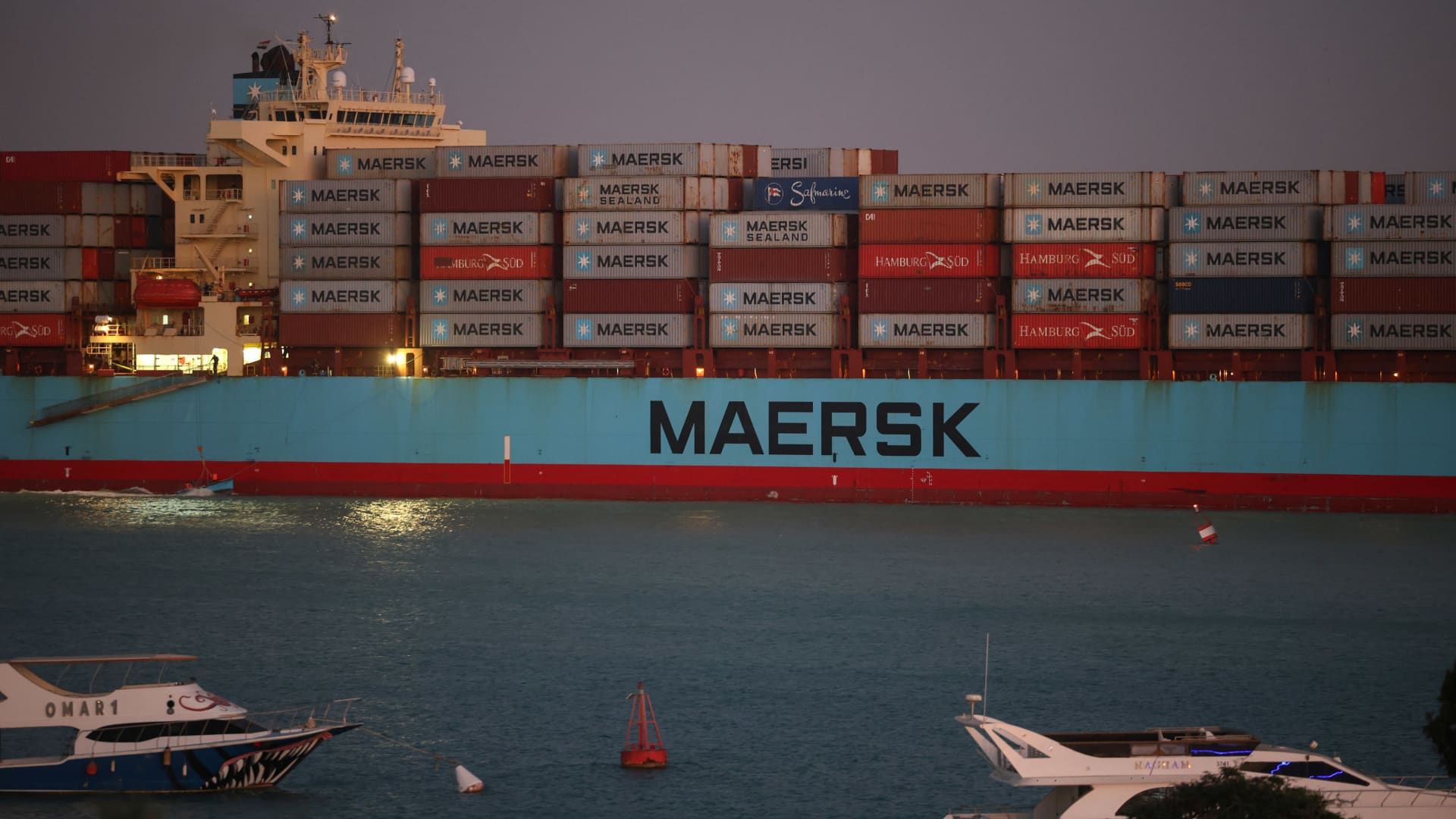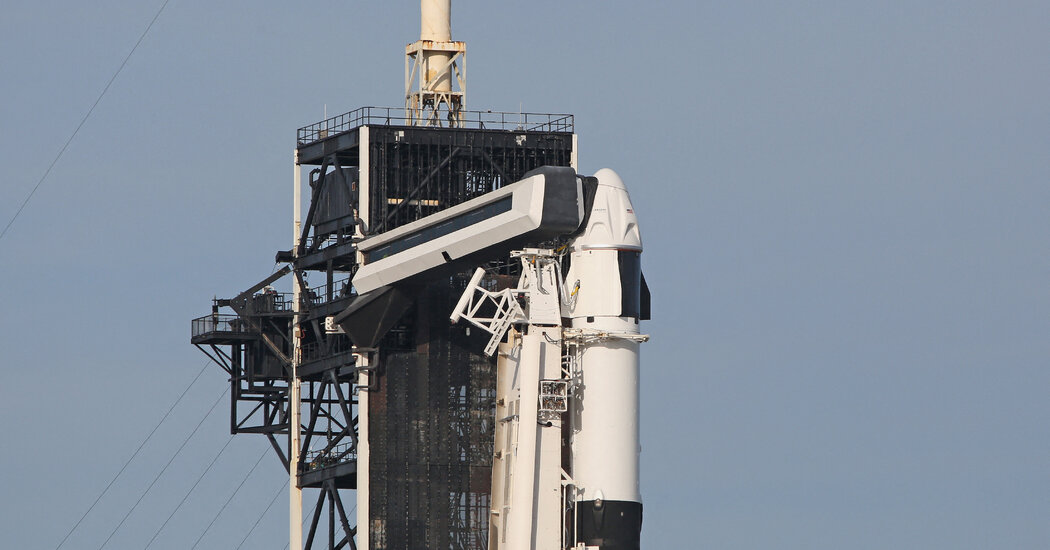The container ship Maersk Sentosa sails south to exit the Suez Canal in Suez, Egypt, Thursday, December 21, 2023.
Stringer | Bloomberg | fake images
Attacks on ships in the Red Sea continue to drive up ocean freight rates, prompting warnings of inflation and delays in goods.
To prevent attacks by Iran-backed Houthi militants based in Yemen, shippers have already diverted more than $200 billion in trade over the past few weeks from the crucial Middle East trade route, which, along with the Canal Suez connects the Mediterranean Sea with the Indian Ocean.
This has created a multi-front storm for global trade, according to logistics managers: freight rates rising daily, additional surcharges, longer shipping times and the threat of spring and summer products arriving late because ships arrive late to China while traveling. the long walk around the Cape of Good Hope in South Africa.
“The supply chain pressures that caused the ‘transitory’ part of inflation in 2022 may be about to return if the problems in the Red Sea and Indian Ocean continue,” said Larry Lindsey, chief executive of the trading firm. global economic advisory Lindsey Group. “Neither the Fed nor the ECB can do anything about this and will probably ‘look into’ the inflation they cause, which could lead to rate cuts despite somewhat higher inflationary pressures.”
The persistent violence against commercial ships prompted a stern warning Wednesday from the United States, Japan, the United Kingdom and nine other nations. “The Houthis will take responsibility for the consequences if they continue to threaten lives, the global economy and the free flow of commerce in the region’s critical waterways,” the countries said in a joint statement.
Meanwhile, around 20% of ship capacity is unused due to a massive drop in manufacturing orders, according to industry experts. Instead, ocean carriers continue to cut their voyages, while tight capacity and longer voyage times are driving rate increases.
Freight rates traveling from Asia to northern Europe more than doubled this week to more than $4,000 per 40-foot equivalent unit (container). Asia and Mediterranean prices rose to $5,175 per container. Some carriers have announced rates above $6,000 per 40-foot container for shipments in the Mediterranean starting in the middle of the month, with surcharges ranging from $500 to $2,700 per container.
A cargo ship crosses the Suez Canal, one of the most critical man-made waterways, in Ismailia, Egypt, on December 29, 2023.
Fareed Kotb | Anadolu | fake images
“Given the sudden upward movement in shipping prices, we should expect to see these higher costs ripple through the supply chain and impact consumers as we move into the first quarter,” said Alan Baer, CEO of the shipping company OL-USA. Companies, reflecting the lessons they learned during the supply chain chaos of 2021-22, will adjust prices sooner rather than later, he added.
Rates from Asia to the east coast of North America have increased 55% to $3,900 per 40-foot container. West Coast prices rose 63% to over $2,700. More shippers are expected to begin avoiding the East Coast in favor of West Coast ports. Additionally, rates are on track to rise again starting January 15 due to previously announced increases.
“This is a big problem, as it has mainly been the decline in goods prices that has eased inflationary tension,” Peter Boockvar, chief investment officer at Bleakly Financial Group, told CNBC. “And while the battles taking place in the Red Sea could end at any time if the war in Gaza ends, it is a reminder to the Federal Reserve that they cannot become complacent about their fight against inflation if they do not want it to happen again. that of the 1970s.”
The impact of longer routes
Detours of Egypt’s Suez Canal, which empties into the Red Sea, are hurting capacity. According to Honor Lane Shipping (HLS), diverting ships around the Cape of Good Hope adds two to four weeks to a round trip. Ocean alliances need more ships on each route between Asia and the East Coast to maintain an efficient network schedule.
“Around 25%-30% of global container shipping volume passes through the Suez Canal (mainly in the Asia-Europe trade), and it is estimated that widespread diversion around Africa could reduce effective global container capacity. container shipping by 10%-15%,” the note said. “As the disruption continues, shippers may have to reduce the number of port calls to offset the impact of longer routes.”
An image capture released by Yemen’s Huthi Ansarullah Media Center on November 19, 2023, purportedly shows members of the rebel group during the capture of an Israeli-linked cargo ship at an undefined location in the Red Sea. Israeli ships are a “legitimate target,” Yemen’s Houthi rebels warned on Nov. 20, a day after capturing the Galaxy Leader and its 25 international crew following an earlier threat to attack Israeli ships over the war between Israel and Hamas. .
– | afp | fake images
The increased travel time could also delay the arrival of spring products that are traditionally picked before the Chinese Lunar New Year, set for February, when factories close and employees go on vacation. According to logistics officials, containers that were due to arrive on the East Coast in December are arriving now. Items include spring and summer clothing, swimming pools, pool supplies, Easter products, patio furniture, and home and garden products.
North American east coast ports in December, amid Houthi attacks, “missed” several calls, which were instead postponed until January, according to data from maritime intelligence firm eeSEA. Instead, the ships will arrive in January and February.
Therefore, ships are not only delayed in dropping off their containers at their final destinations, but are also delayed in returning to Asia to load containers. As a result, HLS encourages customers to reserve their container space four to five weeks in advance to secure a spot.
It is reminiscent of what transportation companies experienced during the early days of Covid.
“We used to book four to six weeks during Covid,” OL-USA’s Baer said. “During Covid, we had too much cargo and all the ships were full, so you have to forecast your reserves. Now, although there is ship capacity, the ships arrive late, so it is complicated to make sure you receive your container at that time. ship.”
Ocean carriers are also expanding ground freight services for those using West Coast ports instead of East Coast ports. This is a similar strategy implemented by Hapag-Lloyd during Covid, when it offered its customers ground service to the west coast from the east coast because it was faster.
These trade diversions will create opportunities for West Coast railroad companies, Union Pacific and BNSF, a subsidiary of Berkshire Hathaway. The additional containers will also be a boost for shipping companies that also serve those ports.
“After the holidays, we are seeing significant volumes being shipped from Asia to the US West Coast and through the Panama Canal to the US East Coast to avoid the Suez Canal,” said Paul Brashier , vice president of drayage and intermodal at ITS. Logistics. “We anticipate this activity will increase as we approach the peak Lunar New Year season.”










